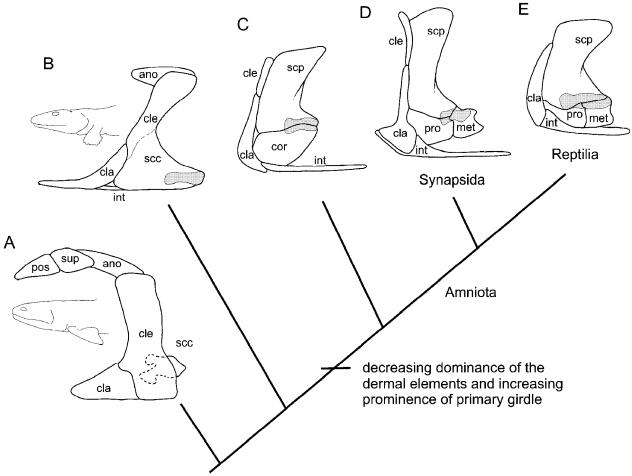Fig. 1.
Evolution of the tetrapod pectoral apparatus. Among basalmost non-digit-bearing tetrapods (A), the pectoral apparatus is dominated by dermal elements; the scapulocoracoid is small and obscured laterally. With the advent of digits (B), taxa demonstrate a trend towards enlargement of the scapulocoracoid while diminishing the dermal contributions. Characteristically, many of these early digit-bearing taxa fuse the scapulocoracoid with the cleithrum (indicated by dashed line). Among sister taxa to amniotes (C), the once unified scapulocoracoid is partitioned into a dorsal scapula and ventral coracoid, with the glenoid nested at the caudal border between the two. Basal members of both major amniote lineages, Synapsida (D) and Reptilia (E), demonstrate a three-part primary girdle consisting of a scapula, procoracoid and metacoracoid. Abbreviations: ano (anocleithrum), cla (clavicle), cle (cleithrum), cor (coracoid), int (interclavicle), met (metacoracoid), pos (post-temporal), pro (procoracoid), scp (scapula), scc (scapulocoracoid), sup (supracleithrum). Glenoid shaded. Phylogeny based on Ruta et al. (2003). Sources for images: (A) †Eusthenopteron modified from Jarvik (1980); (B) †Acanthostega reproduced by permission of the Royal Society of Edinburgh and M. I. Coates from Transactions of the Royal Society of Edinburgh: Earth Sciences, volume 87 (1996), pp. 363–421; (C) †Seymouria modified from Williston (1925); (D) †Dimetrodon modified from Romer & Price (1940) and reproduced with fair use permission from the Geological Society of America; (E) †Captorhinus modified from Gaffney (1990) and reproduced with permission from the American Museum of Natural History. Not to scale.

